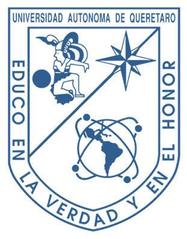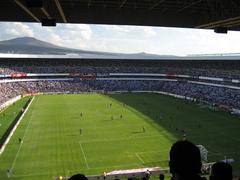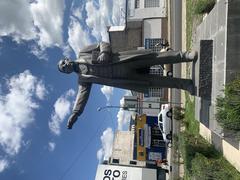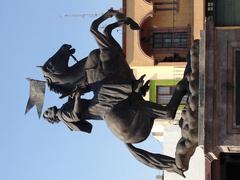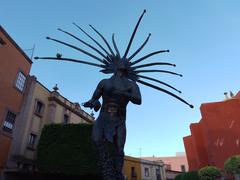Monumento A Colón Visiting Hours, Tickets, and Santiago de Querétaro Historical Sites Guide
Date: 14/06/2025
Introduction
The Monumento A Colón (Columbus Monument) is a prominent symbol within Santiago de Querétaro’s UNESCO World Heritage historic center. Erected in the late 19th century during the Porfirian era, this neoclassical monument commemorates Christopher Columbus and reflects Mexico’s complex colonial history, its evolving identity, and its aspirations for progress. Crafted from locally sourced cantera rosa stone and detailed bronze reliefs, the monument is both an artistic masterpiece and a vital part of Querétaro’s urban and cultural fabric. Its placement in Jardín Colón—a vibrant public plaza surrounded by colonial architecture—makes it a focal point for community life, cultural events, and historical reflection (UNESCO).
This comprehensive guide covers the monument’s historical background, artistic and architectural features, visitor information (including hours, tickets, and accessibility), nearby attractions, practical travel tips, and context about contemporary debates and preservation. Whether you are a history enthusiast, architecture lover, or traveler, this resource will help enrich your experience in Querétaro.
Historical Significance of Monumento A Colón
Origins and Context
Commissioned during a period of political transformation under Porfirio Díaz, the Monumento A Colón was part of a broader Latin American trend to memorialize European explorers and assert modern national identities. The monument honors Columbus as a symbol of exploration, international connectivity, and the perceived progress brought by European influence, while also embodying the complex and sometimes contested legacy of colonization (Wikipedia).
Artistic and Symbolic Features
The monument typically depicts Columbus in a dignified stance, holding a globe—a symbol of discovery and new horizons. The base features bronze reliefs and inscriptions narrating Columbus’s voyages and their significance to the Americas. Surrounding motifs may include allegorical figures, maritime symbols, and references to indigenous cultures, inviting visitors to reflect on the multifaceted impact of the Age of Discovery. Inscriptions and plaques provide historical context and connect the monument to both local and global narratives (Patrimonio Mundial).
Urban Context and Placement
Strategically located in Jardín Colón within Querétaro’s historic center, the monument stands amid a landscape of colonial-era buildings, plazas, and churches. The city’s rectilinear Spanish layout contrasts with the more organic arrangement of indigenous neighborhoods, highlighting the blending of cultures and architectural styles (Conxion Turistica). The monument serves as a gathering point for locals and visitors, reinforcing its role in daily urban life and public memory.
Architectural Design and Integration
Materials and Construction
The monument is primarily constructed from pink cantera stone, a material characteristic of Querétaro’s colonial buildings, with bronze details adding artistic refinement. Its robust pedestal and sculptural elements are designed to harmonize with the surrounding architecture, creating a visual dialogue with nearby landmarks such as the Querétaro aqueduct and various baroque churches (Ask a Mexican).
Plaza and Public Space
Set within a landscaped plaza, the monument is surrounded by paved walkways, benches, and ornamental plants. Nighttime illumination accentuates its features, and the space serves as a venue for community gatherings, festivals, and informal socializing, reinforcing the monument’s ongoing relevance (Julie Around the Globe).
Social and Cultural Context
Festivals and Traditions
Querétaro’s historic center is a stage for religious processions, civic ceremonies, and cultural festivals. Events like the Fiestas de Soriano draw thousands and often integrate the city’s monuments into their routes, further embedding the Monumento A Colón in local traditions (Qronista).
Urban Identity and Community
The city’s historic core, with its preserved colonial fabric and walkable streets, is a hub for civic engagement and social cohesion. Monuments like the Monumento A Colón foster dialogue about identity, belonging, and historical memory in a diverse and rapidly growing urban population (INAH; Scielo).
Safety and Accessibility
Querétaro is regarded as one of Mexico’s safest cities, with a welcoming atmosphere for families, solo travelers, and tourists. The streets and plazas around the monument are pedestrian-friendly and wheelchair accessible (Mexico Travel Buddy; Querétaro Travel).
Visitor Information
Visiting Hours and Admission
- Hours: Jardín Colón and the Monumento A Colón are open to the public daily from 8:00 AM to 8:00 PM, though the plaza itself is accessible 24 hours a day.
- Admission: Access is free; no tickets are required (Life on the Roam; Safe Travel Guide).
Guided Tours
Guided walking tours are available through local agencies and the city’s tourism office. These tours often include historical insights about the monument and other significant sites in the historic center (Epicurean Expats).
Accessibility and Amenities
- Wheelchair Access: The plaza is flat and paved, suitable for wheelchairs and strollers, though some adjacent streets are cobblestoned.
- Restrooms: Available in nearby cafes and public buildings.
- Seating: Benches and shaded areas provide comfort for visitors.
Practical Tips
- Photography: Early morning and late afternoon offer the best lighting. Always ask permission before photographing people, especially during events (World Wide Travel Tips).
- Safety: The area is safe, especially during daylight and early evening. Stay aware of your belongings.
- Weather: Mild, semi-arid climate. Sunscreen and water are recommended, particularly in the dry season.
Suggested Itineraries
Quick Visit (30–45 Minutes)
- Admire the monument and its details in Plaza Colón.
- Take photographs and relax on nearby benches.
- Enjoy a coffee at one of the surrounding cafés.
Half-Day Walk
- Start at Monumento A Colón.
- Visit adjacent plazas such as Jardín Zenea.
- Explore the Church of San Francisco.
- Stroll along Andador 5 de Mayo, a lively pedestrian street.
- Have lunch at a local restaurant.
Full-Day Experience
- Join a guided walking tour including the Monumento A Colón.
- Visit museums such as Museo Regional de Querétaro.
- Enjoy street performances and local markets in the plazas.
- Dine at a restaurant overlooking the monument in the evening.
Nearby Attractions
- Acueducto de Querétaro: 18th-century aqueduct and city landmark (Ask a Mexican).
- Casa de la Corregidora: Historic government building.
- Plaza de Armas: Main city square with colonial architecture.
- Museo Regional de Querétaro: Museum of local history.
- Church of Santa Rosa de Viterbo: Noted for its baroque design (LAC Geographic).
Dining and Refreshments
A wide variety of cafés and restaurants are located near the monument, ranging from traditional Mexican cuisine to international fare. Don’t miss local treats like “Pedos de Monja,” a regional truffle offered in many sweet shops (Life on the Roam).
Conservation and Heritage Status
The Monumento A Colón is protected as part of Querétaro’s Historic Monuments Zone, benefiting from conservation efforts that ensure its preservation for future generations (UNESCO). Restoration projects address weathering, pollution, and vandalism, while educational signage promotes stewardship and public appreciation (Querétaro Travel).
Contemporary Debates and Educational Initiatives
Columbus monuments across the Americas have become focal points in debates about historical memory and colonialism. In Querétaro, rather than removal, authorities have emphasized education and dialogue, encouraging critical reflection on the monument’s meaning and the broader narratives it represents (Wikipedia).
Frequently Asked Questions (FAQs)
Q: What are the visiting hours for Monumento A Colón?
A: The plaza is accessible 24 hours a day, with recommended visits between 8:00 AM and 8:00 PM.
Q: Is there an entrance fee?
A: No, visiting the monument and plaza is free.
Q: Is the monument wheelchair accessible?
A: Yes, though some adjacent streets are cobblestoned.
Q: Are guided tours available?
A: Yes, through local agencies and the city’s tourism office.
Q: Can I attend events at Plaza Colón?
A: Yes, the plaza hosts regular cultural and civic events.
Practical Tips for Visitors
- Language: Spanish is the primary language, but English is commonly spoken in tourist zones.
- Currency: Mexican Peso (MXN); carry cash for small purchases.
- Health and Safety: Pharmacies are nearby; travel insurance is recommended.
- Etiquette: Dress modestly in churches and during festivals; greet locals courteously.
Visuals and Media
- Image placeholder: Monumento A Colón at sunset, highlighting cantera rosa stone and bronze details (alt: Monumento A Colón illuminated at sunset in Querétaro)
- Image placeholder: Aerial view of the historic center of Querétaro featuring the Monumento A Colón and surrounding plazas (alt: Aerial view of Monumento A Colón and Querétaro historic center)
Conclusion
The Monumento A Colón is more than a commemorative statue—it is a dynamic cultural landmark within the living historic core of Querétaro. Free to visit, accessible, and surrounded by architectural marvels and rich traditions, the monument is an ideal starting point for exploring the city’s heritage. Join a guided tour, attend a local event, or simply enjoy the vibrant atmosphere of Jardín Colón to discover Querétaro’s layered history and contemporary life.
For more travel tips, up-to-date visitor information, and deeper insights into Querétaro’s historic sites, consult resources such as Querétaro Travel, Life on the Roam, and Epicurean Expats.
Call to Action
Ready to explore Querétaro’s historic heart? Download the Audiala app for interactive tours, follow us on social media for the latest updates, and start planning your visit to the Monumento A Colón and the many treasures of Santiago de Querétaro.
Sources
- Monument to Christopher Columbus (Charles Cordier), Wikipedia
- Zona de Monumentos Históricos de Querétaro, Patrimonio Mundial
- Querétaro Historic Center, UNESCO World Heritage Centre
- Ciudades Mexicanas Patrimonio Mundial: Zona de Monumentos Históricos de Querétaro, Conxion Turistica
- Things to Do in Querétaro, Julie Around the Globe
- The Aqueduct of Querétaro: History, Construction and Legend, Ask a Mexican
- Monumento a la Corregidora, Asomarte
- Querétaro Travel Official Site
- Las Fiestas de El Soriano, Qronista
- Santiago de Querétaro Urban Identity and Cultural Heritage, INAH
- Urban Green Spaces and Quality of Life in Querétaro, Scielo
- Is Querétaro Mexico Safe? Top Safety Tips for Tourists, Mexico Travel Buddy
- Things to Do in Querétaro, Life on the Roam
- 4 Day Itinerary Querétaro, Epicurean Expats
- Things to Do in Querétaro, Mexico Travel Secrets
- Querétaro Colon: Cautivador y Clásico, Querétaro Travel
- Santiago de Querétaro City Guide, LAC Geographic
- Things to Do in Querétaro, World Wide Travel Tips
- Things to Do in Querétaro, TripSavvy
- Safe Travel Guide Santiago de Querétaro
